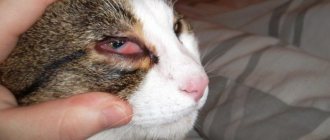During the day, adult cats visit the toilet approximately 2-3 times to urinate. This process takes no more than a minute without any signs of discomfort. Neutered cats do this more often – up to 5 times a day. As the pathology develops, more frequent visits to the litter box and the appearance of blood clots in the urine may occur.
If a cat pees with scarlet blood, this is an alarming sign that indicates the development of serious inflammatory processes and requires urgent treatment. Let's find out why blood appears in a cat's urine and how to help the animal at home.
Signs of hematuria in a cat
“Hematuria” is literally translated from Latin as “bloody urine” (“hema” - blood, “urina” - urine). Indeed, one should be wary if even the slightest traces of blood are detected in cat urine - this cannot in any way be considered a manifestation of the norm and clearly indicates that pathological processes are occurring in the cat’s body.
How to detect blood in a cat's urine
The problem is that detecting blood in the urine in the initial stages of the disease can be very difficult - it often cannot be seen with the naked eye. Most owners notice signs of hematuria, when the problem has developed, there is a lot of blood and the urine has acquired a pronounced color:
- pink;
- scarlet;
- reddish;
- brown.
Sometimes, however, the disease manifests itself immediately and in visible signs - these can be dark red spots, clots in the urine, or even a bloody puddle in the tray. In order not to miss the moment, it is necessary to pay attention not only to obvious, but also to accompanying symptoms, and as soon as you suspect something is wrong, immediately consult a doctor.
In such situations, the animal may become lethargic, apathetic, or, conversely, show increased anxiety - rushing about and meowing plaintively before going to the toilet in a small way. Often, the cat “misses” the tray and pees in the wrong places, thereby indicating to the owner that he is not feeling well.
Video: hematuria in a cat - how and why it happens
Prevention
Although pink urine can occur for a variety of reasons, there are not many methods to prevent this phenomenon. Almost all of them involve careful care of the animal.
Measures to prevent the appearance of blood in the urine of cats:
- The animal must receive the required amount of nutrients from food, so it is very important to monitor its diet and variety in the menu;
- It is necessary to take timely preventive measures against the appearance of worms and fleas, as well as get the necessary vaccinations on time;
- The risk of falling from a height, hitting or fighting should be minimized;
- Walking outside must be supervised. You should walk in a safe area;
- It is necessary to systematically check what type of urine the cat urinates and whether there is any blood in it;
- At the first signs of any disease, you should immediately take your pet to the veterinarian and begin treating it;
It is important to remember that treating a serious disease is much more difficult than preventing it in the early stages.
Causes of blood in urine
Blood can enter the urine either directly from the kidneys or from other organs of the urinary system. Since hematuria is not an independent disease, but only an indicative symptom of a disease or injury, it is urgent to determine its causes and do everything possible to eliminate them.
Blood in the urine is most often a consequence of kidney pathology
Hematuria may have the following causes:
- kidney and urinary tract diseases;
- pathologies of the bladder;
- the presence of stones in the kidneys or bladder;
- inflammatory processes of the genitourinary system;
- various infections;
- reproductive problems;
- injuries;
- endoparasites;
- intoxication, including drug intoxication.
Falls from heights are not as safe for cats as is commonly believed - they can lead to serious injuries.
Quite often, blood in the urine appears after the cat has been injured - for example, it was hit by a car or fell from a balcony. Still, rumors about nine cat lives are greatly exaggerated, and an unsuccessful fall from a height is fraught with significant damage to the animal.
Treatment
After receiving the diagnostic results and visual examination, the veterinarian makes a diagnosis and prescribes the necessary treatment.
Methods to combat hematuria:
- The use of anti-inflammatory, antispasmodic and analgesic drugs;
- For advanced diseases, antibiotics are indicated, administered orally or intramuscularly;
- The use of vitamins, herbal tinctures and drugs to improve immunity;
- The use of drugs to stop bleeding;
- If there are stones in the urinary organs, the animal is prescribed a special diet;
- If the body is dehydrated, intravenous infusions of glucose and physiological solutions are indicated;
- For certain types of poisoning, a veterinarian may prescribe the use of vitamin K1.
- Stones, tumors and other neoplasms are removed surgically;
- If you have problems urinating, you may need to use a urinary catheter.
During pregnancy and after childbirth, the organs of the urinary system can often become inflamed and chronic diseases will worsen, but most medications in this case are contraindicated for use. Therefore, the prescription of treatment should be taken as seriously as possible, because not only the health of the cat, but also its unborn kittens depends on it.
Symptoms of disease development
Blood in a cat’s urine can be a sign of many diseases, which can only be accurately determined at an appointment with a veterinarian. However, primary diagnosis can also be made based on careful observations of the pet - in any case, these data are very important for the doctor and will help him quickly recreate the full picture of the situation.
Table: problems that cause blood in a cat’s urine
| Possible problem | External manifestations of hematuria | Associated symptoms |
| Exacerbation of urolithiasis | The concentration of blood in the urine may vary depending on the degree of injury to the excretory organs by stones |
|
| Acute hemorrhagic cystitis | Urine turns pink or red |
|
| Injury | Copious blood in the urine, possible clots |
|
| Postpartum complications | Bloody discharge mixed with urine, sometimes severe bleeding |
|
| Poisoning, unhealthy diet | Kidney bleeding as a result of intoxication |
|
| Parasitic infestation | Blood impurities appear in the urine if parasites have settled in the bladder or renal pelvis |
|
| Tumors in the genitourinary area | Clots or spots of blood in the urine, sometimes quite large |
|
Video: urolithiasis is a common disease in cats
Hematuria, to varying degrees, can also manifest itself in systemic internal diseases not related to the genitourinary system; among them:
- heart failure;
- liver diseases;
- blood diseases.
Which animals are at risk?
A predisposition to hematuria and frequent diseases of the urinary system appears in cats after castration, and in cats after ovariohysterectomy (removal of the uterus and ovaries). The risk group also includes animals with a monotonous diet.
These cats are at high risk of developing urolithiasis due to altered metabolism from surgery, low motility, and concentrated urine.
Crystals (struvite or oxalates) form in cat urine. They gradually increase in size and transform into conglomerates that damage the walls of the organs of the urinary system. All this leads to the cat starting to pee in blood.
Important! To prevent the development of the disease, it is recommended to take the cat’s urine for analysis once every six months (to detect crystals or inflammation) and feed the animal with a specialized preventive food of good quality.
Diagnostics
The effectiveness of treatment for hematuria in cats depends not only on timely access to the clinic, but also, of course, on how correctly the diagnosis was made. Therefore, it is very important to quickly apply all the necessary diagnostic methods, without refusing the tests offered to you - even the most experienced specialist will not be able to accurately determine the problem “by eye”.
Immediately upon arrival at the clinic, you must undergo a clinical examination by a veterinarian and do three mandatory tests:
- general urine analysis;
- Ultrasound;
- X-ray.
A blood test is the most important test for suspected hematuria
This is a quick and informative diagnosis, the results of which may require additional clarification:
- general blood analysis;
- blood biochemistry;
- urine reaction (pH);
- MRI;
- oncological tests.
Analyzing the research results, the veterinarian first of all tries to exclude or confirm the presence of urolithiasis, since in the vast majority of cases, manifestations of hematuria indicate precisely this disease. Diagnosis must be as prompt as possible; loss of time in many such situations can result in death for the animal.
Care
Treatment for urine leakage will depend on the underlying or related medical conditions that are the underlying cause of the condition. A urinary tract infection may be associated with another urinary tract disease, such as cancer or urinary tract stones (urolithiasis). Or hematuria may be caused by a condition that affects the body as a whole, such as overproduction of steroids by the adrenal glands or diabetes. The systemic generalized condition must be treated before the hematuria can be resolved.
Surgery may be indicated for urinary tract stones, neoplasms, and urinary tract injuries. A blood transfusion may be needed if your cat has very low red blood cell counts. Fluids will be used to treat dehydration, and antibiotics may be used to treat urinary tract infections and general illnesses caused by bacteria in the blood (bacteremia). Urolithiasis and kidney failure may require dietary changes to prevent recurrence.
If your cat has a bleeding disorder, the blood thinner heparin can be used to control it.
How to collect urine for analysis
Before visiting the clinic, if possible, you should collect urine in a sterile jar for analysis. Of course, this procedure can also be done by a veterinarian using a catheter or a sterile syringe (cystocentesis), but such methods are quite traumatic, have a number of side effects and are used in emergency cases when the cat does not pass urine at all. In all other situations, urine can be collected at home.
Urine collection through a catheter is done in the clinic, but this method is traumatic and fraught with infection
Methods and rules for collecting material
To speed up the identification of the causes of illness, you need to independently prepare biomaterial for analysis. It is unlikely that you will be able to persuade your cat to pee directly into a clean jar - although some owners can even do this. Owners, taking into account the habits and character of their pets, use various methods of collecting urine:
- from the toilet, sink or bathtub - if the cat is used to peeing there;
- using a children's urine collector - this device is freely sold in pharmacies;
- from the cat litter box - the most common and reliable method.
To collect urine from the toilet or sink, they are covered with plastic bags or covered with film.
We can recommend that most owners use a regular cat litter box - a plastic tray - as an improvised urinal. This is convenient, reliable and not at all difficult to do if you follow the recommendations of the step-by-step instructions:
- If possible, buy a new tray for collecting biomaterial - even a well-washed old cat litter box can retain residual salts and microorganisms on the walls, which will affect the accuracy of the analysis results.
- Thoroughly wash and dry the tray and the inner grid, assemble the structure and place it in a place familiar to the animal.
- Try to calm your pet and gently massage his bladder area if this does not cause severe pain.
- Such preliminary actions will be enough if your cat is accustomed to pee on an empty tray - all you have to do is collect the urine.
- If the animal refuses to go potty without litter, use one of the options for urine collection kits - they can be purchased at veterinary pharmacies, pet stores or online.
- Sprinkle the filler from the kit in the tray as usual, and when the cat pees, carefully collect the urine - for this, the kit has a special pipette, but you can also use a regular syringe.
- It is important to maintain maximum cleanliness when collecting urine so that unnecessary chemical and biological “additives” do not get into it - thoroughly wash your hands and all the equipment that you will use.
- It is advisable to put the collected urine (in a test tube, syringe or special container) in the refrigerator and deliver it to the veterinary clinic as soon as possible - no more than five hours should pass between the time of collection of the biomaterial and the analysis.
The cat litter box is convenient to use for collecting biomaterial
“Craftsmen” sometimes replace plastic granules with finely chopped cocktail straws or oven-roasted corn kernels - according to reviews, this also works well.
Video: collecting cat urine for analysis
New products from the pet industry for monitoring urine parameters
In veterinary pharmacies, pet stores and via the Internet, you can now purchase many devices and consumables that help you easily collect cat urine for analysis, as well as independently monitor the condition of a cat that has already been diagnosed - for example, urolithiasis. Owners of sick animals are well aware of how important this is, but many of them are not even aware of the existence of such useful and convenient new products.
Table: products for the convenience of collecting urine and monitoring its composition
| Product Name | Purpose | What is | Approximate price |
| Kit for collecting urine from cats “Talismed” (Russia) | Kit for collecting and transporting cat urine |
| 215 rubles |
| Urine collection kit for cats Kruuse KIT4CAT (Denmark) | Kit for collecting and transporting cat urine |
| 1100 rubles |
| Diagnostic tray filler Aromaticat | Tray filler that changes color depending on urine pH | pH indicators are silica gel filler granules | 320 rubles for a 3-liter package |
| Diagnostic tray filler PrettyCat | Rapid cat urine pH test | PrettyCat is poured into the tray on top of any litter, and within a minute of use its granules change color | 180 rubles per 110 gram jar |
| "Uripolian-11A" | Express study of 11 indicators of the composition of cat urine | Test strips that are dipped into fresh urine and quickly display data on the main indicators of analysis | 750 rubles per package for 50 tests |
Urine collection kits, which have already become popular with many owners, make it possible to easily provide biomaterial for analysis to the clinic. They use non-absorbent fillers: hydrophobic sand or plastic granules. One set is enough for several studies.
Do not try to wash plastic granules in order to reuse them, as some overly zealous owners do - this will inevitably distort the analysis results. Pipettes and test tubes are also disposable, but they can be replaced with a sterile syringe, through the needle of which urine is easily collected and then brought directly to the clinic in the syringe.
Important: plastic granules are used only once and then discarded
Diagnostic fillers and express strips are very convenient for independent testing. But they are more often used not in emergency cases, but to monitor the condition of an animal with an already identified chronic disease. It is impossible to make a diagnosis on your own, relying only on their testimony - this must be done by a doctor, especially in case of hematuria.
Photo gallery: devices for collecting urine and monitoring its composition
Aromaticat diagnostic tray filler changes color from orange (normal) to blue (critical)
A urine collection kit with plastic granules is a convenient and relatively inexpensive device
A urine collection kit with hydrophobic sand is not cheap, but is well accepted by cats. Uripolian test strips are produced to study the most important indicators of the composition of urine. PrettyCat diagnostic litter for the tray is used together with any regular litter
Video: making it easy for yourself
What to do and how to provide first aid to an animal?
When a young cat often pees or an old cat suffers from bloody impurities in the urine, then you should not delay treatment. Owners can help the animal at home by doing the following:
- Provide the pet with peace and place it in a dry room.
- The cat should drink freely, and the liquid must always be changed so that it does not stagnate.
- Give the animal food with a liquid consistency.
- Give your cat decoctions based on bearberry or parsley, which are disinfectants.
- Drinking a decoction of juniper and horsetail, through which it is possible to reduce the inflammatory reaction.
How to help your cat yourself
The difficulty of emergency home care is that it is highly undesirable to give your pet any medications before taking tests. Under their influence, the clinical picture may become blurred, and making a correct diagnosis will be difficult. But if it is not possible to urgently take your pet to the clinic, you should still try to alleviate his condition.
If you want to help a sick pet, take him to the clinic
What every owner can do in order not to harm, but at least somehow help the animal:
- provide peace to the sick pet by placing it in a warm, draft-free room on a bedding surface;
- intramuscularly administer pain-relieving antispasmodic drugs (No-shpa, Baralgin), which will relieve pain;
- exclude all solid foods from the diet, instead offer liquid food, easily digestible food, water - without restrictions;
- to disinfect the urinary tract before going to the doctor, give the cat decoctions of bearberry, parsley root, furadonin;
- Inflammatory products are removed from the urinary tract using a decoction of juniper and horsetail.
But even herbal decoctions can become unsafe until an accurate diagnosis is established. The main thing that an owner can do for a sick pet is to take it to the clinic as soon as possible. A personal examination by a doctor cannot be replaced in such a situation by consultations with him by phone, and even more so by advice from friends like “my cat had this too.” Don't waste time - it's pointless and dangerous.
What to do if your cat is peeing blood?
If your cat pees blood, you should immediately contact a veterinarian. If this is not possible, the owner should provide first aid to his pet:
- place the animal in a warm and dry place;
- exclude dry and solid foods from his diet;
- provide free access to drinking water.
It is strictly forbidden to give your cat any medications. Any mistake with the dosage or method of administering the medicine will lead to irreversible consequences. Decoctions of bearberry, parsley or juniper will help reduce inflammation. Remove toxic waste products - horsetail decoction.
Medical assistance
Be prepared for the fact that you may need not only conservative treatment, but also surgery - otherwise you will lose your pet. Urgent surgery is necessary if there are large kidney stones or serious injuries with organ damage and internal bleeding. Surgery followed by chemotherapy may also be recommended for cancer problems.
In a critical situation, only surgery can save the cat's life
In other cases, complex drug therapy is prescribed:
- hemostatic agents;
- antibiotics;
- anti-inflammatory drugs;
- antispasmodics.
Dosages of medications, regimens and duration of treatment can only be determined by a doctor depending on the diagnosis, condition and individual characteristics of the animal. Self-medication for hematuria is strictly unacceptable. It can lead to dangerous complications and negative side effects from poorly chosen drugs.
Kidney structure
The kidneys are a paired oval (bean-shaped in dogs) organ, which in cats is located in the abdominal cavity, in the center of the back (at the level of 7-8 ribs), on both sides of the spine. In this case, the left half may have greater mobility.
The kidneys are made up of nephrons, each of which contains a glomerulus (a collection of capillaries) and a system of tubules. Each nephron is reliably protected from damage by a capsule.
Externally the kidneys look like this:
- The organ is protected from damage by a fibrous capsule, which in turn is located in a fatty capsule, whose thickness depends on the weight of the animal.
- The portal includes the renal artery, through which blood enters the kidneys for purification.
- The renal vein, ureter, and lymphatic vessels emerge from the organ.
- The ureter begins in the renal pelvis and discharges the resulting urine into the bladder.
Diet for cats with kidney disease
When the kidneys are sick, the pet suffers from dehydration. During treatment, be sure to provide him with water - give him wet food, low-sodium broth, tuna juice.
Particular attention should be paid to a diet low in protein and phosphorus. Ask your veterinarian how to feed your pet correctly. The diet should contain a reduced amount of phosphorus and protein, enriched with omega-3 fatty acids.
If you give dry cat food, it is not advisable if you have kidney disease. Give preference to high quality wet food. For example, Dr. has proven himself well. Clauder's Diet Kidney diet for kidney disease. If your pet has stones, for treatment, buy food for cats with kidney disease, which reduces the risk of stones.
Kidney functions
The main job of the kidneys is to remove toxins from the body. It also forms urine, which contains:
- excess liquids, mineral salts, organic substances;
- uric acid;
- urea;
- ammonia, other metabolic products.
Urine flows down the ureters into the bladder, then comes out during emptying.
Other features
- Maintaining water, electrolyte, acid-base balance;
- regulation of blood pressure;
- removal of excess calcium;
- production of the active form of hormone D;
- synthesis of the hormone erythropoietin, which is responsible for the creation of red blood cells in the bone marrow.











